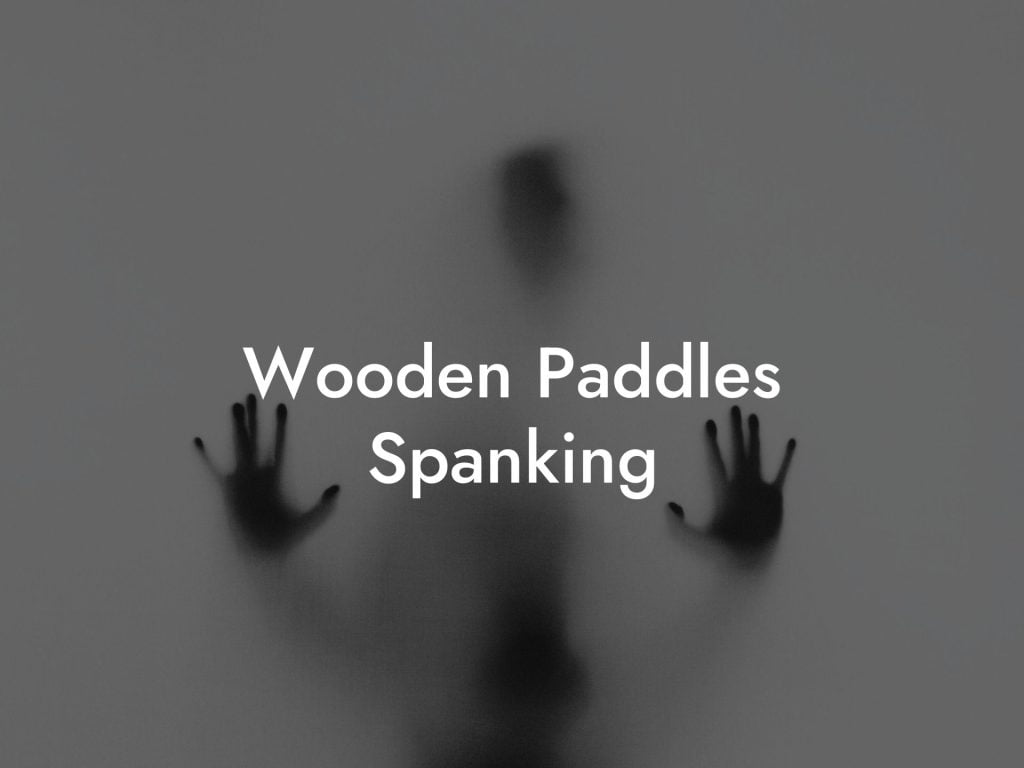Paddling bruises are often associated with BDSM practices, adding an element of excitement and intensity to intimate experiences. Whether you're a seasoned player or a curious beginner, this article will guide you through the art of incorporating paddling bruises into your play. We'll explore various techniques, safety precautions, and aftercare methods to ensure a safe and enjoyable experience. Join us as we delve into the world of kink, BDSM, and everything that makes Filthy Adult the go-to resource for exploration and pleasure.
Paddling Bruises Table of Contents
Paddling bruises can be a thrilling addition to your BDSM repertoire, but it's crucial to approach this practice with caution and knowledge. Below, we'll discuss several key aspects to consider when indulging in paddling play:
Types of Paddles
A wide range of paddles are available, each offering a unique sensation. From leather and silicone to wooden and metal paddles, explore the different materials and their effects on the skin.
Techniques
Discover various techniques like spanking, flogging, and caning to achieve different levels of intensity and sensation. Experiment with different speeds, rhythms, and angles to find what works best for you and your partner.
Consent and Communication
As with any BDSM activity, consent and clear communication are essential. Discuss boundaries, safe words, and limits beforehand to ensure a safe and consensual experience.
Safety Precautions
To prevent any unwanted injuries or complications, take necessary safety precautions. Avoid striking certain areas like the kidneys, spine, or joints. Additionally, maintain good posture and use controlled force to minimize the risk of accidental harm.
Aftercare
Aftercare is crucial for the physical and emotional well-being of all participants. Take the time to provide comfort, nurturing, and reassurance after the session. Gentle massages, cuddles, or warm baths can aid in the healing process and maintain a strong bond between partners.
Frequently Asked Questions
What is BDSM?
BDSM stands for Bondage and Discipline, Dominance and Submission, Sadism and Masochism. It refers to a range of practices and expressions that involve power dynamics, consensual exchange of control, and erotic or physical play involving various activities such as bondage, discipline, and impact play.
What is impact play in BDSM?
Impact play is a BDSM practice where one person is struck (the submissive) by another person (the dominant) for the sexual gratification of either or both parties. Common implements used in impact play include floggers, paddles, whips, or even hands (spanking).
How do floggers differ from paddles in impact play?
Floggers are typically made up of multiple strands or 'tails' and provide a thudding sensation upon impact, allowing for a range of sensations from light and stingy to heavy and thuddy. Paddles, on the other hand, are usually flat and can produce a sharper, more intense impact that is felt over a smaller area.
What are some safety considerations when using floggers and paddles?
Safety considerations include starting slowly to gauge the submissive's reaction, avoiding hitting the spine or kidney area, and being cautious of the force used to prevent bruising or damage. Aftercare is crucial to address any marks, injuries, or emotional responses post-play. Regular communication and consent are essential.
Can anyone participate in BDSM power dynamics?
Yes, with consent and a clear understanding of the responsibilities and boundaries involved, any consenting adults can participate in BDSM power dynamics. It's important to have a trust foundation, and mutual respect, and to engage in thorough pre-play discussions to determine limits and safewords.
How important is consent in BDSM?
Consent is the cornerstone of all BDSM interactions. All parties must give informed, enthusiastic, and voluntary consent. Consent must be ongoing, and participants have the right to withdraw it at any point. Safe words and gestures should be established to communicate withdrawal of consent during play.
What does 'safe, sane, and consensual' mean?
'Safe, sane, and consensual' is a principle that underpins the BDSM community to ensure that all play is safe (risks are minimized), sane (everyone is of sound mind and judgments are not impaired), and consensual (all participants have fully agreed to the activities and understand the implications).
What is a safeword, and how is it used?
A safeword is a pre-agreed code word or phrase that participants can use during BDSM activities to communicate a need to pause, check-in, or stop the scene. It is a critical aspect of maintaining consent and safety. Safewords should be easy to remember and recognize even in a distressed state.
How do trust and safety intertwine in BDSM relationships?
Trust and safety are fundamental in BDSM relationships since activities may involve a high level of vulnerability and risk. Trust is established through open communication, respect for boundaries, and adherence to agreed-upon rules. Practicing risk-aware consensual kink (RACK) or personal responsibility, informed consensual kink (PICK) can also help maintain safety.
What is aftercare, and why is it important?
Aftercare refers to the time and attention given to participants after a BDSM scene to ensure their physical and emotional wellbeing. It may involve physical care like treatment for any marks or pain, as well as emotional support to bring individuals back to a grounded state. It helps to prevent sub-drop and reinforces the bond between the participants.
How can one negotiate a BDSM scene?
Negotiation in a BDSM scene involves discussing and agreeing upon the activities that will take place, roles, boundaries, safewords, and any specific needs or concerns. This should happen before any activity commences, ensuring that everyone has a clear expectation and mutual consent.
Are there psychological impacts associated with BDSM?
BDSM can have both positive and negative psychological impacts, depending on how it is practiced and the individual’s responses. It can lead to increased intimacy, improved mental health, and personal fulfillment when done consensually and with attention to safety and aftercare. However, negative impacts can occur without proper consent, preparation, or aftercare.
What's the difference between a submissive and a slave in BDSM?
A submissive chooses to submit for a period, often within agreed-upon scenes or dynamics, and may have specific limits and safewords. A slave, in some BDSM power exchange relationships, agrees to surrender control more extensively, possibly in a total power exchange (TPE), potentially without an explicit safeword. Such relationships require deep trust and extensive negotiation.
How can I ensure that my BDSM activities are legal?
To ensure BDSM activities are legal, you must understand and abide by the laws in your jurisdiction regarding consent, sexual activity, and physical harm. Only engage in activities with consenting adults and avoid any acts that could be interpreted as non-consensual harm. When in doubt, consult with legal advice.
Can BDSM activities cause physical harm?
If not practiced responsibly and with care, BDSM activities can cause physical harm. Educate yourself about the human body, the correct use of implements, and the practices you are engaging in. Be aware of the submissive’s health status and any potential risks involved, and have safety measures and a first-aid kit readily available.
What role does communication play in a BDSM context?
Communication is essential in BDSM to ensure that all activities are consensual, safe, and enjoyable for all participants. It's necessary to discuss limits, desires, and expectations before engaging in play, to check in during the scene, and to debrief afterwards during aftercare.
How can one be a responsible member of the BDSM community?
Being a responsible member of the BDSM community involves respecting others' boundaries, practicing informed consent, being discreet about others' identities and activities, and contributing to a culture of safety and support. Education, mutual respect, and adherence to community etiquette are also essential.
How do beginners safely explore BDSM?
Beginners can safely explore BDSM by starting slow, educating themselves on practices, negotiation, consent, and safety. It’s beneficial to communicate openly with partners, set clear boundaries, and use safewords. Engaging with the BDSM community for mentorship or attending workshops can also provide valuable guidance.
Is jealousy ever an issue in BDSM dynamics?
Yes, jealousy can be an issue in BDSM dynamics just as it can in any relationship. Open and honest communication about feelings and boundaries is essential. Some individuals may negotiate polyamorous arrangements or consensual cuckolding scenes, but these, too, require careful management of emotions and expectations.
What should I do if my BDSM boundaries are violated?
If your BDSM boundaries are violated, it's important to communicate this to your partner immediately and halt the scene if necessary. After addressing any immediate safety concerns, discuss what happened in a calm setting, establish the cause of the violation, and evaluate if you feel safe continuing the relationship. Seeking support from friends, community members, or a counselor may also be beneficial.
We hope this article has opened your mind to the exciting world of paddling bruises. Remember, safety, consent, and communication are paramount when indulging in BDSM practices. Visit Filthy Adult to explore our wide range of artisan-made spanking paddles, including the exquisite WeSpank collection. Dive deeper into the world of kink by reading other exciting guides on our blog and browse through our fetish shop to enhance your intimate explorations. Share this article with others who are interested in the realm of BDSM and help build our engaging community.













